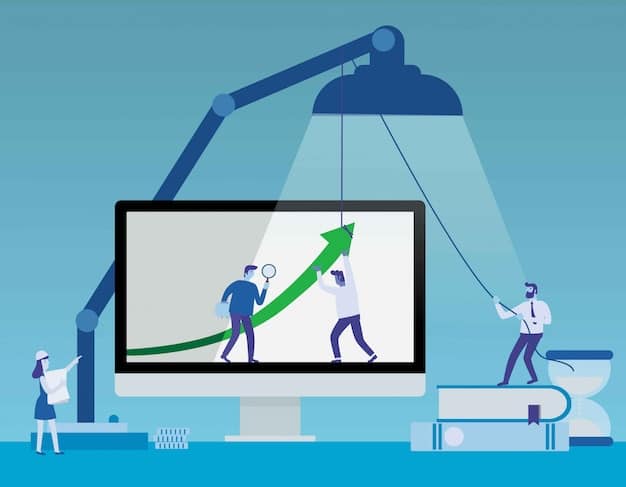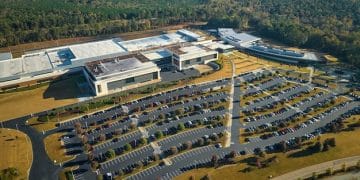US Tech Skills Gap: Companies & Universities Train 100,000 Engineers

The US tech skills gap is being addressed through partnerships between companies and universities, aiming to train 100,000 new engineers by 2027, focusing on crucial areas like AI, cybersecurity, and software development to meet industry demands.
The **US Tech Skills Gap: How Companies Are Partnering with Universities to Train 100,000 New Engineers by 2027** is a pressing issue, but innovative collaborations are emerging to tackle the problem head-on, ensuring the US remains competitive in the global tech landscape.
Understanding the US Tech Skills Gap
The tech skills gap in the US represents a significant challenge to sustained economic growth and innovation. It highlights the discrepancy between the skills demanded by tech companies and the abilities of the available workforce.
This gap isn’t just about a lack of skilled workers; it’s about a rapid evolution in technology that outpaces traditional education systems. Companies are struggling to find professionals proficient in areas like artificial intelligence, cybersecurity, data science, and cloud computing.
Why is there a skills gap in the tech industry?
Several factors contribute to this gap. Firstly, technology evolves incredibly quickly. Curricula at universities and colleges often lag behind the latest industry trends making it challenge to keep up with emerging technology and teaching it to students. Secondly, traditional education pathways might not adequately prepare students for the practical demands of tech roles, which often require hands-on experience and specialized training.
Another piece to consider is that demand for tech jobs has outstripped the supply of qualified candidates. As more industries become digitized, the need for professionals skilled in software development, data analytics, and IT infrastructure expands rapidly. Finally, potential candidates are sometimes not located in the same geographical areas as tech companies, making recruitment a challenge from a location point of view.
The impact of the skills gap on the US economy
The tech skills gap presents several significant consequences for the US economy. Companies may struggle to innovate and can slow the pace of technological advancement and thus overall economic growth. The increased cost of hiring and training tech talent can also raise operational expenses for businesses. This can reduce overall market competitiveness.
- Reduced competitiveness in the global market
- Slower innovation and technological advancements
- Increased costs associated with recruitment and training
The tech skills gap is a multifaceted problem that demands strategic solutions. By acknowledging the evolving nature of tech, updating educational frameworks, and expanding training initiatives, the nation can better equip its workforce to meet the demands of the digital age.

The Role of Universities in Bridging the Gap
Universities play a pivotal role in addressing the tech skills gap by updating curricula, fostering industry partnerships, and integrating real-world skills into their programs. These institutions are crucial in ensuring that graduates are well-prepared with the competencies and knowledge that employers want.
To stay ahead of the curve, universities are collaborating with tech companies to learn about industry-specific needs and incorporate those requirements into course content. These can range from cybersecurity to new advances in network enginereeing and beyond. This approach can help to align academic instruction with the actual need for real employees.
Curriculum updates for tech relevance
One of the most crucial steps universities can take is to regularly update their curricula to mirror advances in the tech sector. By introducing new courses on AI, machine learning, data analytics, and cybersecurity, universities can arm students with up-to-date skills that are highly sought after. These courses should be structured to provide both theoretical knowledge and hands-on practical experience.
Another piece to consider is that faculty should maintain continuing education and training in their respective fields. By doing so they stay current with technological advances and can provide that knowledge to their students. Investment in this continuous learning is an investment in the students.
Industry partnerships and experiential learning
Partnerships between universities and tech companies offer unique opportunities for experiential learning, such as internships, co-op programs, and research collaborations. Through these experiences, students can apply their knowledge in real-world settings, work on practical projects, and develop an understanding of industry dynamics.
- Internships provide hands-on experience and professional skills
- Co-op programs integrate classroom learning with work experience
- Research collaborations tackle industry-relevant challenges
These kinds of partnerships also foster a smooth transition for students into the workforce. By engaging with leading companies as part of academic training, students gain insight into the expectations and culture of these companies. This gives them a leg up when beginning their careers.
Universities are instrumental in bridging the tech skills gap through curriculum updates and strategic industry partnerships. This combination makes higher education a tool for producing a workforce prepared to drive tech innovation well into the future.
How Companies are Partnering with Universities
Tech companies are actively partnering with universities to create specialized training programs, offer resources for curriculum development, and provide opportunities for students to gain practical experience. These collaborations are essential to shaping the next generation of tech professionals.
The partnerships often involve a combination of financial aid, shared resources, and joint program development. By combining the skills and funds of both partners, it betters chances to effectively training new engineers that will close the tech skills gap.

Creating specialized training programs
One of the key strategies for tech companies involves creating specialized training programs. Companies like Google, Microsoft, and Amazon have launched programs that focus on AI, cloud computing, and cybersecurity. These programs often include courses, workshops, and certifications designed to provide students with targeted skills.
These programs also increase the talent pool for the companies that provide them. Graduates who successfully finish these courses are often targeted hires and can quickly fill the open job roles that many tech companies are struggling to fill.
Resources and curriculum development
Tech companies also contribute resources for curriculum development, providing universities with access to tools, software, and expertise. This infusion of industry knowledge ensures that academic programs remain relevant and up-to-date. Curriculum updates also address current employer needs.
- Access to cutting-edge technology and software
- Expert insights into industry trends and requirements
- Financial support for curriculum enhancements
These alliances foster a vibrant ecosystem that empowers students and faculty to innovate and explore cutting-edge technologies. This collaboration ensures that students receive education that directly addresses the critical demands of the tech industry.
Tech companies are playing an active role with universities to bridge the tech skills gap. These contributions help to prepare students for the demands of the tech sector, ensuring a steady supply of skilled professionals for the US technology industry.
The 100,000 New Engineers Initiative
The ambitious initiative to train 100,000 new engineers by 2027 represents a crucial step in addressing the tech skills gap in the US. This program involves collaboration between dozens of corporations and universities to enhance tech education and train skilled professionals.
This initiative aims to ensure that the United States remains competitive in the global tech landscape by providing companies with access to a constant pool of engineers. It is important to realize that this initiative is not just about quantity. It is also about ensuring the students have the skills needed to directly contribute to their respective industries.
Goals and scope of the program
The primary goal of the 100,000 New Engineers initiative is to significantly increase the number of tech graduates with expertise in high demand areas such as AI, cybersecurity, and software development. This initiative aims for education and work experience to provide tangible value that directly supports emerging technologies.
To achieve this goal, the initiative is structured around multiple key pillars. First is strategic funding which is vital for enhancing university programs. Next, is providing opportunities for experiential learning which help students hone their skills. Finally, strategic partnership which fosters collaboration between academia and industry.
Expected outcomes and impact
The anticipated outcomes of the 100,000 New Engineers initiative include a substantial increase in the number of qualified tech professionals, reduced time-to-hire for tech companies, and improved innovation across various industries.
- Increased workforce readiness in emerging technologies
- Enhanced competitiveness for US tech companies
- Boosted innovation and economic growth
Successful execution of the 100,000 New Engineers initiative could greatly benefit the US tech industry. It will strengthen the nation’s capacity for technological innovation and economic prosperity.
The initiative to train 100,000 new engineers by 2027 is a bold endeavor that promises to significantly bolster the US tech workforce. By combining strategic investments, experiential learning, and strong partnerships, this initiative aims to create a robust pipeline of skilled professionals ready to drive technological advancements and economic growth.
Challenges and Opportunities Ahead
Despite the promising initiatives, several challenges remain in effectively bridging the tech skills gap. Addressing these obstacles, while leveraging emerging opportunities, is crucial for sustained progress.
One major challenge involves the digital divide, which limits access to tech training for certain populations. Another area to consider is that ongoing technological advancements necessitate that training programs must consistently evolve to keep pace. Addressing these challenges requires collaboration, innovation, and strategic investments.
Addressing the digital divide
The digital divide refers to the gap between those who have access to modern information and communication technologies and those who do not. Addressing this disparity requires targeted efforts to ensure that all communities, regardless of socioeconomic status or geographic location, have equal access to tech education and resources.
Focusing on equity ensures that opportunities will be available to all and not just those who come from privilege. This will result in a wider pool of candidates and thus more innovation and perspective when tackling the current tech skills gap that the US is facing.
Keeping up with technological advancements
The pace of technological advancement presents a continuous challenge for education providers and training programs. To stay ahead, curricula must be flexible and adaptive, incorporating new technologies as they emerge. This might involve updating course content regularly.
- Continuous curriculum updates and improvements
- Flexible training programs
- Collaborating with industrial leaders to understand advance notice of new skills to be prepared for
Collaboration between industry and academia is essential for ensuring that education programs remain current and relevant. By working together, universities and companies can proactively address the evolving needs of the tech sector.
Addressing the challenges and leveraging opportunities in the tech skills landscape requires a multifaceted approach. By focusing on inclusivity, adaptability, and strong collaboration, the US can create a tech workforce that can thrive for many years to come.
The Future of Tech Skills Training
The future of tech skills training is expected to involve more personalized learning, increased use of online platforms, and a greater emphasis on continuous, lifelong learning. These trends will transform how professionals acquire and update their skills to meet the demands of the tech industry.
Personalized learning approaches will enable students to customize their learning pathways based on their individual needs and preferences. Online platforms will provide greater access to education, breaking down geographical barriers and offering flexible learning. Furthermore, the importance of lifelong learning will become increasingly important.
Personalized and adaptive learning approaches
Personalized learning tailors the educational experience to meet individual needs, preferences, and learning styles. Adaptive learning technologies adjust the level of difficulty and content based on a learner’s performance in real time. This helps to maximize efficiency and engagement in the learning process.
These approaches also help to empower the students with education. Giving them the tools they need to succeed based on their needs and preferences. This not only increases their investment in the subject matter but also their results at the end of the training.
The role of online learning platforms
Online learning platforms are becoming important in modern education. These platforms offer accessibility, allowing individuals to learn wherever they are. They also provide a flexible schedule. By supporting self-paced learning, online platforms enable students to balance their studies with other commitments.
- Increased accessibility and flexibility
- Cost-effectiveness
- A wide range of courses and specializations
Looking forward, online learning platforms can become even more vital in training skilled tech professionals to help close the skills gap. As these evolve, so will the methods of learning for future generations to come.
The future of tech skills training involves personalized learning, use of online platforms, and an emphasis on lifelong learning. Embracing these changes promises to ensure that the tech industry has a steady supply of skilled professionals.
| Key Topic | Brief Description |
|---|---|
| 🎓 Skills Gap | Mismatch between tech skills demanded and workforce abilities. |
| 🤝 University Partnerships | Companies and universities collaborate to create specialized training programs. |
| 🚀 100,000 Engineers Initiative | Ambitious plan to train new engineers by 2027. |
| 🌐 Online Learning | Online platforms allow for increased access to education. |
FAQ
The US tech skills gap refers to the difference between the tech skills that companies need versus those that are available in the workforce. The main issue is a talent shortage for a quickly growing tech industry.
Companies collaborate with universities through creating specialized training programs, providing resources for creating curricula, and providing students with practical, hands-on experience in specific fields.
The goal is to train 100,000 new engineers who will work to combat tech skills gap. By ensuring that a steady supply of candidates is available, that will keep the US competitive in tech.
Companies are creating their own online courses. This enables them to find the right talent wherever that person is located. Additionally, they are sponsoring those who show promise in the field.
The US will be able to maintain its status as a world leader by closing the skills gap. By helping to train future generations in the tech industry, the US will remain ahead of potential foreign adversaries.
Conclusion
In conclusion, collaborative efforts between companies and universities are key to addressing the US tech skills gap and making the 100,000 New Engineers initiative a success. By focusing on curriculum updates, partnerships, and tech advancement strategies, the US can create a skilled tech workforce that drives innovation and ensures competitiveness.





